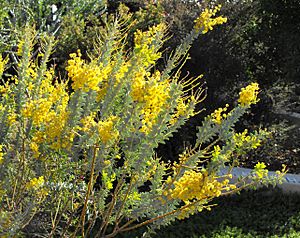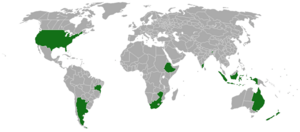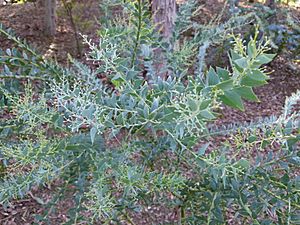Knife-leaf wattle facts for kids
Quick facts for kids Knife-leaf wattle |
|
|---|---|
 |
|
| Scientific classification | |
| Genus: |
Acacia
|
| Species: |
cultriformis
|
 |
|
| Occurrence data from AVH | |
| Synonyms | |
|
|
The Acacia cultriformis, also known as the knife-leaf wattle, dogtooth wattle, half-moon wattle or golden-glow wattle, is a type of tree or shrub. It grows year after year and is native to Australia. This plant is grown in many places around the world. It has even started growing on its own in parts of Asia, Africa, North America, New Zealand, and South America. The Knife-leaf wattle can grow up to about 4 meters (13 feet) tall. It has unique triangle-shaped "leaves" called phyllodes. Its bright yellow flowers usually bloom from August to November in Australia. Because of its interesting "leaves" and pretty flowers, it's a very popular plant for gardens.
Contents
What is the Knife-leaf Wattle?
How it Got its Name
A Scottish plant expert named George Don first described the Acacia cultriformis in 1832. He called it the "cultriform-leaved acacia." The word "cultriformis" comes from Latin and means "knife-shaped." This name perfectly describes the plant's special knife-shaped "leaves" or phyllodes.
Another botanist, Les Pedley, tried to change its scientific name in 2003. He suggested calling it Racosperma cultriforme. However, most experts still use the original name, Acacia cultriformis. The name Racosperma cultriforme is now just seen as a synonym, which means it's another scientific name for the same plant.
People often call this plant by several common names. These include knife-leaf wattle, golden glow wattle, half-moon wattle, or dog-tooth wattle.
What Does it Look Like?
The Acacia cultriformis is a woody shrub. It can grow straight up or spread out, reaching up to 4 meters (13 feet) tall. Its branches can be smooth or covered with a white, powdery layer.
Older Knife-leaf wattle plants don't have true leaves. Instead, they have special flattened stems called phyllodes. These phyllodes look like leaves and do the same job. They are crowded closely along the stems. The phyllodes are green to green-grey and have a unique triangle shape. They are about 1 to 3 centimeters long and 0.6 to 1.5 centimeters wide. Each phyllode has a small nectar gland at its widest part.
Its Unique Flowers and Pods
This wattle blooms from August to November, and it can have many flowers, especially on the upper parts of the plant. The flowers are bright yellow and round. They grow in clusters of 2 to 25 flowers. These clusters form along stems called racemes, which are 1 to 8 centimeters long.
After flowering, the plant produces seed pods. These pods are straight or slightly curved. They are usually 3 to 10 centimeters long and 0.4 to 0.75 centimeters wide. The pods are somewhat flat, with bumps over each seed. The seeds inside are shiny black and oblong, about 3.5 to 4.5 millimeters long. Each seed has a club-shaped attachment called an aril.
Where Does the Knife-leaf Wattle Grow?
The Acacia cultriformis is found in central New South Wales and southern Queensland in Australia. It grows on the western slopes of the Great Dividing Range. You can find it from Wagga Wagga and Narrandera in the south, heading north. It also grows west of Denman and Singleton, up to Stanthorpe and Inglewood.
This plant prefers to grow in clay-loam or sandstone soils. It is often found in Eucalyptus woodlands, especially on rocky ridges.
How People Use and Grow It
The Knife-leaf wattle is one of the most popular wattle plants grown in gardens. People love its bright yellow flowers and interesting triangle-shaped "leaves." It can adapt to many different types of soil and can handle cold weather. It grows well in sunny spots or places with some shade.
This plant is also good at handling dry conditions. Because of this, it can be used to help stop soil from washing away. There's even a special type called Acacia ‘Cascade’. This version grows flat along the ground and can spread out to 2 meters (7 feet) wide. It was first grown by Bill Molyneux in 1982. This spreading type looks beautiful cascading over rocks in a rockery.
Besides being a garden plant, A. cultriformis flowers are used as cut flowers for bouquets. The flowers are also edible, meaning you can eat them! They are sometimes used as an ingredient in fritters. People can also get yellow dye from the flowers and green dye from the seed pods.


